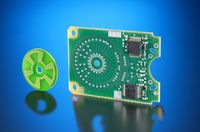Digital Progress: New Generation Of Sensors Replaces Analog Technology
LIPPSTADT, Germany – December 10, 2008: Analog vehicle sensors can be replaced easily and economically with modern digital solutions. The basis is the new SENT protocol for data transmission in cars. Hella has developed a new generation of sensors with contactless measurement for this. The first application is the recording of throttle-body position; it will go into production in the fall of 2009.
These days, sensors are fitted at numerous locations in cars. For reasons of costs, connection to digital data-bus systems is not worth it in every case. Thus, for example, the throttle-body sensor is often connected directly to the control unit, and the data transmission takes place in analog form. It is much more advantageous to carry this out digitally. This is possible with the SENT protocol and the CIPOS (Contactless Inductive Position Sensor) sensors from Hella. SENT stands for Single Edge Nibble Transmission. Engineers use the term "one nibble" to refer to a data quantity of 4 bits. In the SENT protocol, it is transmitted with each pulse. In relation to this, the pulses are evaluated only on the basis of the falling edges, hence "Single Edge". CIPOS on the other hand, refers to the series of contactless inductive position sensors from Hella. The advantages of these sensors for travel and angle measurement can be seen particularly in applications in the engine compartment, such as in throttle bodies. High temperatures and vibrations mean that an insensitive measuring system is necessary here.
SENT is the newest standard for communication within vehicle-electric-system electronics. A big advantage is the compact and simple design of the corresponding applications. One cable with three single wires is sufficient for the supply of the sensor and the data transmission to the control unit. In addition, two signals can run over the data wires, which means that costs for additional cables can be saved. In contrast to other technical approaches, screened or twisted cables are not necessary, because the signals of the SENT protocol are very insensitive to interference.
The technology allows easy and economical replacement of analog transmission. In electronic sensors, the sensor information - the throttle-body angle, for example - is usually converted into a digital value and processed. An interface then turns this into the analog signal, which the receiver at the end of the cable in turn converts into a digital one. In this process, due to the multiple conversion from digital to analog signals and vice versa, there is a whole series of interference effects, the minimization or detection of which is costly.
In contrast, in the case of digital transmission via SENT, the data remains completely digital - from conversion in the CIPOS sensor to processing in the control unit. In relation to this, different measures ensure the reliability of the data. Unlike analog transmission, signals on digital transmission routes cannot be falsified without detection. A big advantage of the solution from Hella is also the high electromagnetic compatibility (EMC).
Hella will go into production with the digitally controlled throttle-body sensor in the fall of 2009. A further application could be the recording of steering torque. Here, the possibility of transmitting a second signal is especially advantageous, such as for the steering angle.



